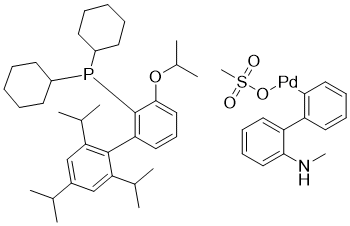Online Database of Chemicals from Around the World
| Zhengzhou Kingorgchem Chemical Technology Co., Ltd. | China | Inquire | ||
|---|---|---|---|---|
 |
+86 (371) 6551-1006 | |||
 |
sales@kingorgchem.com | |||
 |
QQ chat | |||
 |
WeChat: 18625597674 | |||
| Chemical manufacturer since 2015 | ||||
| chemBlink standard supplier since 2016 | ||||
| Classification | Organic raw materials >> Aryl compounds >> Biphenyl compounds |
|---|---|
| Name | EPhos Pd G4 |
| Molecular Structure |  |
| Molecular Formula | C50H70NO4PPdS |
| Molecular Weight | 918.55 |
| CAS Registry Number | 2132978-44-8 |
| SMILES | CC(C)c1cc(c(c(c1)C(C)C)c2cccc(c2P(C3CCCCC3)C4CCCCC4)OC(C)C)C(C)C.CNc1ccccc1c2ccccc2[Pd]OS(=O)(=O)C |
| Hazard Symbols |
 GHS07 Warning Details
GHS07 Warning Details |
|---|---|
| Hazard Statements | H302-H315-H319-H335 Details |
| Precautionary Statements | P261-P305+P351+P338 Details |
|
EPhos Pd G4 is a specialized palladium complex that has emerged as a significant advancement in catalytic chemistry. This compound is a member of the EPhos ligand family, which is renowned for its effectiveness in facilitating various chemical transformations. EPhos Pd G4 combines a palladium center with a unique phosphine ligand, designed to enhance catalytic performance in synthetic chemistry. The discovery of EPhos Pd G4 represents a critical development in ligand design, driven by the need for more efficient and selective catalytic systems. The "EPhos" prefix refers to a class of phosphine ligands with carefully engineered electronic and steric properties. In EPhos Pd G4, the palladium center is coordinated with a phosphine ligand that features bulky groups and electron-donating functionalities. These design elements are crucial for stabilizing the palladium center and optimizing its reactivity. EPhos Pd G4 is particularly notable for its applications in cross-coupling reactions, such as the Suzuki-Miyaura, Heck, and Negishi reactions. These reactions are fundamental in organic synthesis, enabling the formation of carbon-carbon bonds that are essential for constructing complex molecules. EPhos Pd G4 enhances these processes by improving the palladium catalyst's stability and reactivity, leading to higher yields and selectivity. One of the key features of EPhos Pd G4 is its ability to facilitate reactions with challenging substrates. The ligand's structure allows it to accommodate sterically hindered molecules and promote efficient catalytic cycles. This capability makes EPhos Pd G4 valuable in scenarios where traditional palladium catalysts might struggle, such as with bulky or electron-rich substrates. In addition to cross-coupling reactions, EPhos Pd G4 has found applications in other catalytic transformations, including carbonylation and C-H activation. Its versatility is attributed to the unique properties of the EPhos ligand, which can be tuned to suit specific reaction conditions. This adaptability allows chemists to tailor the catalyst to achieve optimal performance in a wide range of synthetic processes. The development of EPhos Pd G4 has also contributed to the broader understanding of palladium catalysis. Studies involving this complex have provided insights into how ligand design influences the reactivity and stability of palladium catalysts. These insights are valuable for designing new catalytic systems with enhanced performance and selectivity. Overall, EPhos Pd G4 exemplifies the advancements in palladium catalysis achieved through innovative ligand design. Its effectiveness in facilitating complex reactions and its ability to handle challenging substrates make it a powerful tool in modern synthetic chemistry. As research continues, compounds like EPhos Pd G4 will likely play a crucial role in advancing both academic and industrial chemical synthesis. |
| Market Analysis Reports |
| List of Reports Available for EPhos Pd G4 |